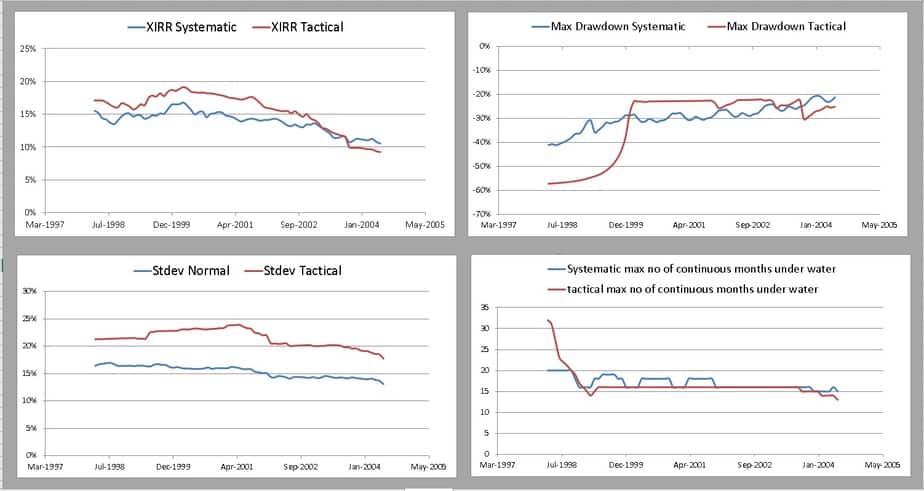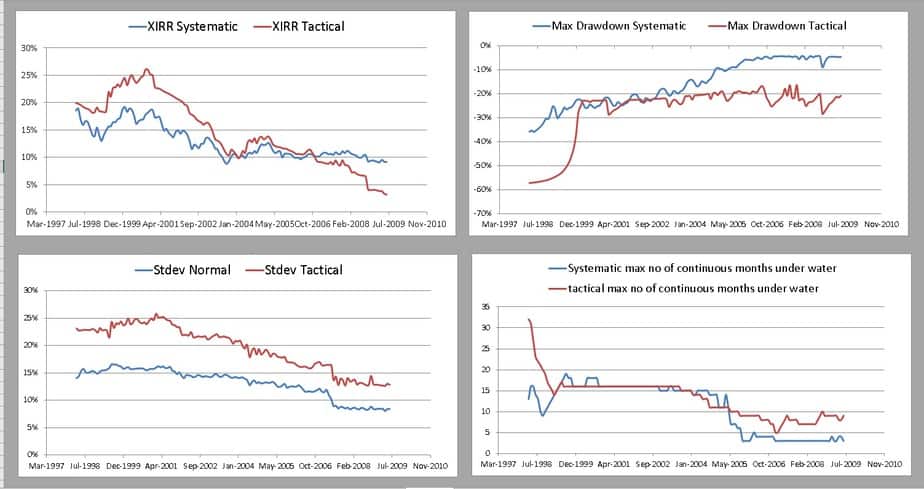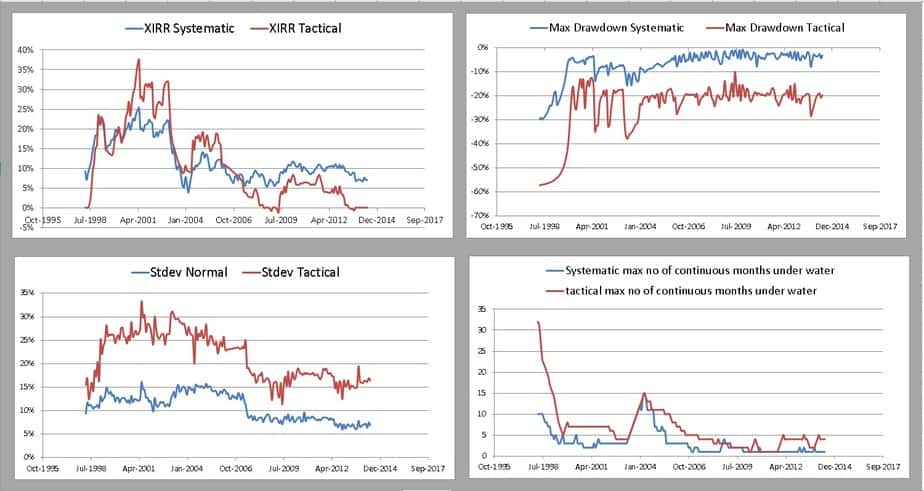Last Updated on December 29, 2021 at 4:49 pm
Momentum investing is such a simple strategy that it could even invite ridiculing laughter. Yet, it works: Momentum Stock Investing in India: Does it work? Yesterday the Momentum, Low Volatility Stock Screener June 2019 was released. This allows you to screen for momentum stocks with low volatility (quality momentum) among the Nifty 100 stocks. In this post, we ask what if we used a Nifty Momentum model to time the market.
Before we begin, if you forgot to check out the latest videos, here they are (watch them after you read this post!) [1] Do not make these 15 investing mistakes!! [2] Personal Finance: Know Where You Stand Checklist (free download!) [3] How to generate tax-free income from mutual funds
What is momentum investing? It quite simply means, look at the past 6-12 months returns of a security and if it is moving up, buy it or buy more of it. Once it stops moving up (or moving up less) dump it and buy another with higher momentum. There some nuances like looking for momentum quality. That is upward movement with less volatility and also relative momentum we two asset classes or even securities are compared.
Important: The results you see below have nothing to do with momentum stock investing. The pros and cons of momentum stock investing are quite different where one will have to consider a higher rate of churn, especially in the mid and small cap space. This is the reason why I have restricted myself to the Nifty 100 space.
Join 32,000+ readers and get free money management solutions delivered to your inbox! Subscribe to get posts via email! (Link takes you to our email sign-up form)
🔥Want to create a complete financial plan? Learn goal-based investing? Exclusive access to our DIY tools? Increase your income with your skills? Use this link to enjoy massive discounts on our robo-advisory tool & courses! 🔥
Warning and Disclaimer
The following is to be treated as investment research based on past data unrepresentative of practical implementation and is not investment advice. They do not factor in behavioral/emotional aspects associated with investing. If you do not know how to understand a backtest result, evaluate its disadvantages, then please, please DO NOT play with your money using market timing. Please watch this video before proceeding further.
What is meant by tactical asset allocation (TAA)?
Asset allocation is the ratio of much equity, fixed income, gold, cash etc. is present in a portfolio. We will only consider equity and fixed income in this study. Tactical asset allocation (TAA) refers to changing these allocations based on certain factors or indicators.
What is market timing?
It is a technique to reduce portfolio risk and/or enhance portfolio returns by changing asset allocation based on our reading of where the market will head in the near future. This can be the stock market, bond market, gold market etc.
Is tactical asset allocation necessary?
Yes, as the risk associated with a portfolio must be systematically reduced or contained to ensure we have enough money for our future needs.
Is market timing necessary?
No. Tactical asset allocation is necessary and one need not resort to market timing to do this. TAA is possible based on a target corpus associated with a financial goal. See:
Part 1 How to reduce risk in an investment portfolio
Part 2 Do we need to time the market?
Part 3 Why we need to gradually pull out of equity investments well before we need the money!
Can we time the market?
Yes. However, realistic and reproducible market timing methods have often primarily reduced risk with or without return enhancement. See results here: Want to time the market with Nifty PE? Learn from Franklin Dynamic PE Fund and here: Is it possible to time the market?
Previous parts on the tactical asset allocation series1:
1: Do we need to time the market?
2: Market Timing with Index PE Ratio: Tactical Asset Allocation Backtest Part 1
3: Market Timing With Ten Month Moving Average: Tactical Asset Allocation Backtest Part 2
4: Tactical Asset Allocation Backtest Part 3: Short-Term Vs Long-Term
What is the Nifty Momentum Timing model?
I have considered two different types of datasets for backtesting. We use Franklin India Blue Chip Fund for the Equity component and
We consider the past six-month returns of both equity and debt. If the equity return is higher than debt, then invest in equity and sell off all existing debt and invest in equity. If the debt return is greater than equity, then invest in debt, sell off equity and invest everything in debt. This might sound drastic, but let us quantify it.
Systematic investing A total amount of Rs. 1000 will be invested into the portfolio in specified asset allocation (50:50). The systematic portfolio will be rebalanced once a year. To account for exit loads and tax associated with this, the final portfolio amount will be reduced by 4%.
Tactical investing with the rules detailed above. The final tactical portfolio is reduced by 20% (this is 5 times the amount assumed for the systematic portfolio as the average no of trades in 10Y is about 5). This 20% accounts for exit loads of equity and fixed income and tax associated with equity.
Fifteen years, 60:40 asset allocation
First, we shall consider all possible 15 year periods and the systematic investment will have 60% equity and 40% debt asset allocation with annual rebalancing. The tactical asset allocation will swing from 100% equity (if last 6 months equity returns > last 6 months debt returns) to 0% (for opposite scenario).
Astoundingly the avg number of equity sell-offs is only 12-13 . This means, although we are looking at the last 6 month returns each month, the equity holding has been sold less than a year on average for 15-year intervals. Why is this astounding because in the systematic portfolio, for 15Y, there will be 15 rebalancing events!
 Top Left: The XIRR or returns are compared. Higher the better!
Top Left: The XIRR or returns are compared. Higher the better!
Top Right: The maximum fall of the portfolio from a peak is compared. The vertical axis is negative. So lower the value, the more the fall, the more the risk.
Bottom left: Standard deviation or how much the monthly returns fluctuate is compared. Higher the value, the higher the fluctuation, the higher the risk.
Bottom right: The no of months, the portfolio was continuously lower than a previous peak (underwater) is compared. Higher the no of months, higher the risk.
The Nifty momentum timing strategy is clearly a higher risk, potentially higher strategy and seems to have worked reasonably well in the past in term of return. However, a higher risk is a guarantee and that is a problem. The drawdown (fall from peak) is higher but the no of months the portfolio is continuously underwater is not much different.
Ten years, 50:50 asset allocation
Here we consider a 5-:50 allocation for the systematic investment with annual rebalancing. The no of equity sell-offs over a10 year period was only 8 on average.
 Again the performance of the momentum timing is reasonable.
Again the performance of the momentum timing is reasonable.
Five years, 40:60 asset allocation
Finally a 5-year duration (risky, and not advisable, but still for the sake of backtesting). Here the higher return practically becomes a coin toss.
Summary
The Nifty momentum timing model is more riskier than a systematic approach with annual rebalancing. For this extra risk, sometimes the reward is higher and sometimes not. However, surprising the portfolio churn is quite acceptable and actually lower than the systematic portfolio!!
Some improvements to the timing model studied are possible: Including volatility of monthly returns during the six month period and varying the six-month duration. I will take that up if there is interest.
Check out the Momentum, Low Volatility Stock Screener June 2019

Use our Robo-advisory Tool to create a complete financial plan! ⇐More than 3,000 investors and advisors use this! Use the discount code: robo25 for a 20% discount. Plan your retirement (early, normal, before, and after), as well as non-recurring financial goals (such as child education) and recurring financial goals (like holidays and appliance purchases). The tool would help anyone aged 18 to 80 plan for their retirement, as well as six other non-recurring financial goals and four recurring financial goals, with a detailed cash flow summary.
🔥You can also avail massive discounts on our courses and the freefincal investor circle! 🔥& join our community of 8000+ users!
Track your mutual funds and stock investments with this Google Sheet!
We also publish monthly equity mutual funds, debt and hybrid mutual funds, index funds, and ETF screeners, as well as momentum and low-volatility stock screeners.
You can follow our articles on Google News

We have over 1,000 videos on YouTube!

Join our WhatsApp Channel



- Do you have a comment about the above article? Reach out to us on Twitter: @freefincal or @pattufreefincal
- Have a question? Subscribe to our newsletter using the form below.
- Hit 'reply' to any email from us! We do not offer personalised investment advice. We can write a detailed article without mentioning your name if you have a generic question.
Join 32,000+ readers and get free money management solutions delivered to your inbox! Subscribe to get posts via email! (Link takes you to our email sign-up form)
About The Author
 Dr M. Pattabiraman (PhD) is the founder, managing editor and primary author of freefincal. He is an associate professor at the Indian Institute of Technology, Madras. He has over 13 years of experience publishing news analysis, research and financial product development. Connect with him via Twitter(X), LinkedIn, or YouTube. Pattabiraman has co-authored three print books: (1) You can be rich too with goal-based investing (CNBC TV18) for DIY investors. (2) Gamechanger for young earners. (3) Chinchu Gets a Superpower! for kids. He has also written seven other free e-books on various money management topics. He is a patron and co-founder of “Fee-only India,” an organisation promoting unbiased, commission-free, AUM-independent investment advice.
Dr M. Pattabiraman (PhD) is the founder, managing editor and primary author of freefincal. He is an associate professor at the Indian Institute of Technology, Madras. He has over 13 years of experience publishing news analysis, research and financial product development. Connect with him via Twitter(X), LinkedIn, or YouTube. Pattabiraman has co-authored three print books: (1) You can be rich too with goal-based investing (CNBC TV18) for DIY investors. (2) Gamechanger for young earners. (3) Chinchu Gets a Superpower! for kids. He has also written seven other free e-books on various money management topics. He is a patron and co-founder of “Fee-only India,” an organisation promoting unbiased, commission-free, AUM-independent investment advice.Our flagship course! Learn to manage your portfolio like a pro to achieve your goals regardless of market conditions! ⇐ More than 3,500 investors and advisors are part of our exclusive community! Get clarity on how to plan for your goals and achieve the necessary corpus no matter the market condition!! Watch the first lecture for free! One-time payment! No recurring fees! Life-long access to videos! Reduce fear, uncertainty and doubt while investing! Learn how to plan for your goals before and after retirement with confidence.
Increase your income by getting people to pay for your skills! ⇐ More than 800 salaried employees, entrepreneurs and financial advisors are part of our exclusive community! Learn how to get people to pay for your skills! Whether you are a professional or small business owner seeking more clients through online visibility, or a salaried individual looking for a side income or passive income, we will show you how to achieve this by showcasing your skills and building a community that trusts and pays you. (watch 1st lecture for free). One-time payment! No recurring fees! Life-long access to videos!
Our book for kids: “Chinchu Gets a Superpower!” is now available!


Must-read book even for adults! This is something that every parent should teach their kids right from their young age. The importance of money management and decision making based on their wants and needs. Very nicely written in simple terms. - Arun.Buy the book: Chinchu gets a superpower for your child!
How to profit from content writing: Our new ebook is for those interested in getting a side income via content writing. It is available at a 50% discount for Rs. 500 only!
Do you want to check if the market is overvalued or undervalued? Use our market valuation tool (it will work with any index!), or get the Tactical Buy/Sell timing tool!
We publish monthly mutual fund screeners and momentum, low-volatility stock screeners.
About freefincal & its content policy. Freefincal is a News Media organisation dedicated to providing original analysis, reports, reviews and insights on mutual funds, stocks, investing, retirement and personal finance developments. We do so without conflict of interest and bias. Follow us on Google News. Freefincal serves more than three million readers a year (5 million page views) with articles based only on factual information and detailed analysis by its authors. All statements made will be verified with credible and knowledgeable sources before publication. Freefincal does not publish paid articles, promotions, PR, satire or opinions without data. All opinions will be inferences backed by verifiable, reproducible evidence/data. Contact Information: To get in touch, please use our contact form. (Sponsored posts or paid collaborations will not be entertained.)
Connect with us on social media
- Twitter @freefincal
- Subscribe to our YouTube Videos
- Posts feed via Feedburner.
Our publications
You Can Be Rich Too with Goal-Based Investing
 Published by CNBC TV18, this book is designed to help you ask the right questions and find the correct answers. Additionally, it comes with nine online calculators, allowing you to create custom solutions tailored to your lifestyle. Get it now.
Published by CNBC TV18, this book is designed to help you ask the right questions and find the correct answers. Additionally, it comes with nine online calculators, allowing you to create custom solutions tailored to your lifestyle. Get it now.Gamechanger: Forget Startups, Join Corporate & Still Live the Rich Life You Want
 This book is designed for young earners to get their basics right from the start! It will also help you travel to exotic places at a low cost! Get it or gift it to a young earner.
This book is designed for young earners to get their basics right from the start! It will also help you travel to exotic places at a low cost! Get it or gift it to a young earner.Your Ultimate Guide to Travel
 This is an in-depth exploration of vacation planning, including finding affordable flights, budget accommodations, and practical travel tips. It also examines the benefits of travelling slowly, both financially and psychologically, with links to relevant web pages and guidance at every step. Get the PDF for Rs 300 (instant download)
This is an in-depth exploration of vacation planning, including finding affordable flights, budget accommodations, and practical travel tips. It also examines the benefits of travelling slowly, both financially and psychologically, with links to relevant web pages and guidance at every step. Get the PDF for Rs 300 (instant download)
